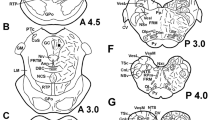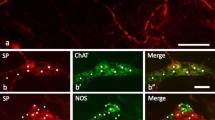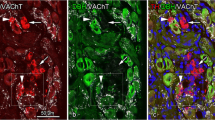Abstract
Four types of substance P-immunoreactive structures have been distinguished in the rat superior cervical ganglion by double-immunofluorescence microscopy: (1) A major population of mainly varicose fibres enmeshed singly-scattered neuronal perikarya, some of which contained vasoactive intestinal polypeptide-immunoreactivity. These substance P-immunoreactive fibres did not contain colocalized calcitonin gene-related peptide (CGRP) and were absent after transection of the cervical sympathetic trunk. (2) A rather small substance P-immunoreactive fibre population with colocalized calcitonin gene-related peptide-immunoreactivity was distributed in a patchy manner and disappeared after cutting the postganglionic branches. (3) Most of the intraganglionic small intensely fluorescent (SIF) cell clusters were intensely substance P-immunoreactive. SIF cells were not visibly changed in number and fluorescence intensity by either surgical procedure. (4) Immunoreactivity was not visible in principal ganglionic neurons of control ganglia, but occurred in cell bodies after pre- as well as after postganglionic nerve transection. Some of the substance P-immunolabelled perikarya in addition revealed immunostaining to antisera against the catecholamine-synthesizin enyzme tyrosine hydroxylase or against the neuropeptides leu-enkephalin and vasoactive intestinal polypeptide, respectively. The results strongly suggest that, in addition to a substance P-containing preganglionic input (1), and a supply by substance P-containing sensory axon collaterals (2), the superior cervical ganglion of the rat gives origin to a paraganglionic (3) and a postganglionic (4) substance P-immunoreactive intrinsic system, the latter becoming visible only after disconnection of the sympathetic pathway.
Similar content being viewed by others
References
Adler JE, Black IB (1984) Plasticity of substance P in mature and aged sympathetic neurons in culture. Science 225:1499–1500
Baker SG, Cuello AC, Matthews M (1980) Substance P-containing synapses in a sympathetic ganglion and their possible origin as collaterals from sensory nerve fibres. J Physiol (Lond) 308:76–77
Couraud JY, Frobert Y, Conrath M, Renzi D, Grassi J, Drapeau G, Regoli D, Pradelles P (1987) Monoclonal antibodies to substance P: production, characterization of their fine specificities and use in immunocytochemistry. J Neurochem 49:1708–1719
Dalsgaard CJ, Hökfelt LG, Elfvin LG, Skirboll L, Emson P (1982) Substance P containing primary sensory neurons projecting to the inferior mesenteric ganglion: evidence from combined retrograde staining and immunohistochemistry. Neuroscience 7:647–657
Darvesh S, Nance DM, Hopkins DA, Armour JA (1987) Distribution of neuropeptide-like immunoreactivity in intact and chronically decentralized middle cervical and stellate ganglia of dogs. J Auton Nerv Syst 21:167–180
Gamse R, Wax A, Zigmond RE, Leeman SE (1981) Immunoreactivity for substance P in sympathetic ganglia: distribution and sensitivity towards capsaicin. Neuroscience 6:437–441
Gibbins IL, Furness JB, Costa M (1987a) Pathway-specific patterns of coexistence of substance P, calcitonin gene-related peptide, cholecystokinin and dynorphin in neurons of the dorsal root ganglia of the guinea pig. Cell Tissue Res 248:417–437
Gibbins IL, Wattchow D, Coventry B (1987b) Two immunohisto-chemically identified populations of calcitonin gene-related peptide (CGRP)-immunoreactive axons in human skin. Brain Res 414:143–148
Heym C (1985) Neuropeptides in paraganglia of various mammals. Fortschr Zool 30:563–569
Heym C, Kummer W (1988) Regulatory peptides in paraganglia. Progr Histochem Cytochem 18:1–92
Heym C, Reinecke M (1984) Immunohistochemistry of neuropeptides in cat paraganglia. In: TJB v Wimersma Greidatmus (ed) Frontiers in hormone research. Karger, Basel, vol 12, pp 91–94
Heym C, Webber R, Horn M (1990) Neuronal pathways in the guinea pig lumbar sympathetic ganglia as revealed by immuno-histochemistry. Histochemistry 93:547–557
Heym C, Klimaschewski L, Common B, Yin SY, Couraud JY, Bachmann S (1993a) Neurochemistry, connectivity and plasticity of small intensely fluorescent (SIF) cells in the rat superior cervical ganglion. An Anat (in press)
Heym C, Liu N, Gleich A, Oberst P, Kummer W (1993b) Immuno-histochemical evidence for different substance P- and calcitonin gene-related peptide (CGRP)-immunoreactive pathways in the guinea pig stellate ganglion. Cell Tissue Res (in press)
Hökfelt T, Elfvin LG, Schultzberg M, Goldstein M, Nilsson G (1977) On the occurrence of substance P-containing fibers in sympathetic ganglia: immunohistochemical evidence. Brain Res 132:29–41
Kessler JA, Black IB (1982) Regulation of substance P in adult rat sympathetic ganglia. Brain Res 234:182–197
Kessler JA, Adler JE, Bolen MC, Black IB (1981) Substance P in principal sympathetic neurons: regulation by impulse activity. Science 214:335–336
Kessler JA, Adler JE, Black IB (1983) Substance P and somatostatin regulate sympathetic noradrenergic function. Science 221:1059–1061
Konishi S, Otsuka M, Folkers K, Rosell S (1983) A substance P antagonist produces non cholinergic slow excitatory postsynaptic potential in guinea-pig sympathetic ganglia. Acta Physiol Scand 117:157–160
Krukoff TL, Ciriello J, Calaresu FR (1985) Segmental distribution of peptide-like immunoreactivity in cell bodies of the thoracolumbar sympathetic nuclei of cat. J Comp Neuron 240:90–102
Kummer W, Heym C (1988) Neuropeptide distribution in the cervico-thoracic paravertebral ganglia of the cat with particular reference to calcitonin gene-related peptide immunoreactivity. Cell Tissue Res 252:463–471
Kummer W, Heym C, Colombo, Lang R (1986) Immunohisto-chemical evidence for extrinsic and intrinsic opioid systems in the guinea pig superior cervical ganglion. Anat Embryol 174:401–405
Kummer W, Reinecke M, Heym C, Forssmann WG (1988) Distributon of opioid peptides functionally related to the cardiovascular system. In: Stumpe KO, Kraft E, Faden AI (eds) Opioid peptides and blood pressure control. Springer, Berlin Heidelberg New York, pp 5–12
Kuramoto H, Kondo M, Fujita T (1985) Substance P-like immuno-reactivity in adrenal chromaffin cells and intraadrenal nerve fibres of rats. Histochemistry 82:507–512
Lee Y, Takami K, Kawai Y, Girgis S, Hillyard CJ, MacIntyre I, Emson PL, Tohyama M (1985) Distribution of calcitonin gene-related peptide in the rat peripheral nervous system with reference to its coexistence with substance P. Neuroscience 15:1227–1237
Libet B (1976) The SIF cell as a functional dopamine-releasing interneuron in the rabbit superior cervical ganglion. In: Eränkö O (ed) SIF cells: structure and function of the small, intensely fluorescent sympathetic cell. Fogarty International Center Proceedings No. 30, pp 163–177
Lindh B, Pelto-Huikko M, Schalling M, Lundberg JM, Hökfelt T (1990) Substance P is present in CGRP-containing cholinergic paravertebral sympathetic neurons in the cat. Evidence from combined in situ hybridization and immunohistochemistry. Neurosci Lett 107:1–5
Matthews MR, Cuello C (1982) Substance P-immunoreactive peripheral branches of sensory neurons innervate guinea pig sympathetic neurons. Proc Natl Acad Sci USA 79:1668–1672
Matthews MR, Nelson VH (1975) Detachment of structurally intact nerve endings from chromatolytic neurons of rat superior cervical ganglion during the depression of synaptic transmission induced by postganglionic axotomy. J Physiol (Lond) 245:91–135
Murata Y, Shibata H, Chiba T (1982) A correlative quantitative study comparing the nerve fibres in the cervical sympathetic trunk and the locus of the somata from which they originate in the rat. J Auton Nerv Syst 6:323–333
Roach A, Adler JE, Black IB (1987) Depolarization influences regulate preprotachykinin mRNA in sympathetic neurons. Proc Natl Acad Sci USA 84:5078–5081
Schmitt M, Kummer W, Heym CH (1988) Calcitonin gene-related peptide (CGRP)-immunoreactive neurons in the human cervico-thoracic paravertebral ganglia. J Chem Neuroanat 1:287–292
Schultzberg M, Hökfelt T, Terenius L, Elfvin LG, Lundberg JM, Brandt J, Elde RP, Goldstein M (1979) Enkephalin-immunoreactive nerve fibres and cell bodies in sympathetic ganglia of the guinea pig and rat. Neuroscience 4:249–270
Schultzberg S, Lindh B (1988) Transmitters and peptides in autonomie ganglia. In: Björklund A, Hökfelt T, Owman C (eds) Handbook of chemical neuroanatomy 6:297–326
Weihe E, Nohr D, Hartschuh W (1988) Immunohistochemical evidence for a cotransmitter role of opioid peptides in primary sensory neurons. Progr Brain Res 74:189–196
Wessendorf MW, Elde RP (1986) Characterization of an immuno-fluorescence technique for the demonstration of coexisting neurotransmitters within nerve fibres and terminals. J Histochem Cytochem 33:984–994
Author information
Authors and Affiliations
Rights and permissions
About this article
Cite this article
Heym, C., Common, B., Klimaschewski, L. et al. Immunohistochemical evidence from co-localization and denervation studies for four types of substance P-containing nervous structures in the rat superior cervical ganglion. Anat Embryol 187, 485–492 (1993). https://doi.org/10.1007/BF00174424
Accepted:
Issue Date:
DOI: https://doi.org/10.1007/BF00174424




